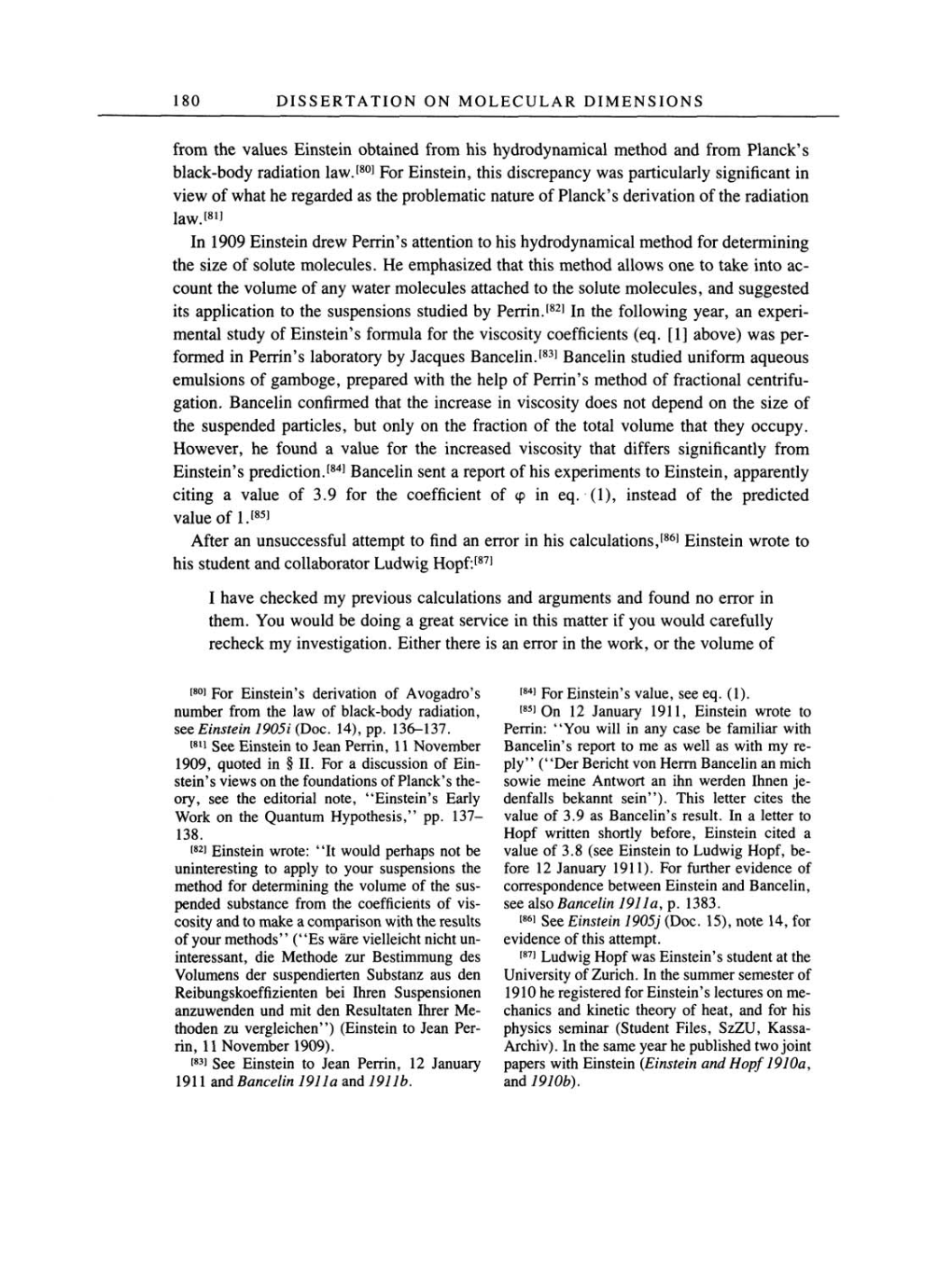180
DISSERTATION
ON
MOLECULAR
DIMENSIONS
from the
values Einstein obtained from his
hydrodynamical
method and
from Planck's
black-body
radiation
law.[80]
For
Einstein,
this
discrepancy was particularly significant
in
view
of
what he
regarded as
the
problematic
nature
of Planck's derivation of
the radiation
law.[81]
In 1909 Einstein drew
Perrin's
attention to his
hydrodynamical
method for
determining
the size
of
solute molecules. He
emphasized
that this method allows
one
to
take
into
ac-
count the volume
of
any
water
molecules attached to the solute molecules, and
suggested
its
application
to
the
suspensions
studied
by
Perrin.[82]
In the
following
year, an
experi-
mental
study
of Einstein's
formula for the
viscosity
coefficients
(eq.
[1]
above) was per-
formed in
Perrin's
laboratory by Jacques
Bancelin.[83]
Bancelin studied uniform
aqueous
emulsions
of
gamboge, prepared
with the
help
of Perrin's
method
of
fractional centrifu-
gation.
Bancelin confirmed that the increase
in
viscosity
does not
depend on
the size
of
the
suspended particles,
but
only on
the fraction
of
the total volume that
they
occupy.
However,
he found
a
value for the increased
viscosity
that differs
significantly
from
Einstein's
prediction.[84]
Bancelin sent
a report
of
his
experiments
to
Einstein,
apparently
citing
a
value
of
3.9 for the coefficient
of
p
in
eq.
(1),
instead
of
the
predicted
value
of
1.[85]
After
an
unsuccessful
attempt
to find
an error
in
his
calculations,[86]
Einstein
wrote to
his student and collaborator
Ludwig
Hopf:[87]
I
have checked
my previous
calculations and
arguments
and found
no error
in
them. You would
be
doing
a
great
service in this matter
if
you
would
carefully
recheck
my investigation.
Either there is
an
error in
the
work, or
the
volume of
[80]
For
Einstein's
derivation
of
Avogadro's
number from the law
of
black-body
radiation,
see
Einstein
1905i
(Doc. 14),
pp.
136-137.
[81]
See Einstein
to
Jean
Perrin,
11
November
1909, quoted
in
§
II.
For
a
discussion
of
Ein-
stein's
views
on
the foundations
of Planck's
the-
ory, see
the editorial
note,
"Einstein's
Early
Work
on
the
Quantum
Hypothesis,"
pp.
137-
138.
[82]
Einstein wrote:
"It
would
perhaps
not be
uninteresting
to
apply
to
your suspensions
the
method for
determining
the volume
of
the
sus-
pended
substance from the coefficients
of
vis-
cosity
and
to
make
a comparison
with the results
of
your
methods"
("Es wäre vielleicht nicht
un-
interessant, die Methode
zur Bestimmung
des
Volumens der
suspendierten
Substanz
aus
den
Reibungskoeffizienten
bei Ihren
Suspensionen
anzuwenden und
mit
den Resultaten
Ihrer
Me-
thoden
zu
vergleichen") (Einstein
to Jean
Per-
rin,
11
November
1909).
[83]
See Einstein
to
Jean
Perrin,
12
January
1911
and Bancelin 1911a
and
1911b.
[84]
For
Einstein's
value,
see
eq. (1).
[85]
On
12
January
1911,
Einstein wrote
to
Perrin:
"You will in
any case
be familiar
with
Bancelin's
report to me as
well
as
with
my
re-
ply" ("Der
Bericht
von
Herrn Bancelin
an
mich
sowie meine Antwort
an
ihn werden Ihnen
je-
denfalls bekannt sein"). This letter cites the
value
of 3.9
as
Bancelin's
result. In
a
letter
to
Hopf
written
shortly
before,
Einstein cited
a
value
of
3.8
(see
Einstein to
Ludwig
Hopf,
be-
fore
12
January
1911).
For further evidence
of
correspondence
between Einstein and
Bancelin,
see
also Bancelin 1911a,
p.
1383.
[86]
See Einstein
1905j (Doc. 15),
note
14,
for
evidence
of
this
attempt.
[87]
Ludwig
Hopf
was
Einstein's
student at the
University
of
Zurich. In the
summer
semester
of
1910 he
registered
for
Einstein's
lectures
on me-
chanics and kinetic
theory
of
heat,
and for his
physics
seminar
(Student
Files, SzZU,
Kassa-
Archiv).
In the
same year
he
published
two
joint
papers
with Einstein (Einstein
and
Hopf 1910a,
and
1910b).
